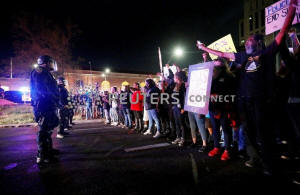|
California AG sees no grounds for
charging police in black man's killing
 Send a link to a friend
Send a link to a friend
 [March 06, 2019]
By Sharon Bernstein [March 06, 2019]
By Sharon Bernstein
SACRAMENTO, Calif. (Reuters) - California's
top law enforcement official said on Tuesday he has found no grounds to
criminally charge two Sacramento policemen who shot an unarmed black man
to death last year, but federal prosecutors have opened a civil rights
probe into the matter.
Announcing the findings of his independent inquiry, Attorney General
Xavier Becerra agreed with the Sacramento County district attorney's
conclusion that the two officers had sound reason to believe the man
they shot, Stephon Clark, 22, posed a lethal threat to them.
The D.A.'s decision on Saturday not to prosecute the officers, who
police said mistook Clark's cell phone for a gun, has angered community
activists and touched off three nights of protests in Sacramento, the
state capital.
At a City Council meeting Tuesday night, hundreds of angry people packed
the council chambers, speaking to the mayor and council members for
about four hours, becoming raucous at times with many in the crowd
calling for the firing of the city's police chief, the Sacramento Bee
reported online.

The meeting ended shortly before 9 p.m. local time, with the crowd
dispersing and no immediate reports of additional protests.
Becerra, speaking to reporters after a lengthy private meeting on
Tuesday with Clark's mother and other relatives, said the 11-month probe
by his office closes the criminal investigation of what he called a
"tragedy."
But the U.S. Attorney for the Eastern District of California, McGregor
Scott, later said his office will conduct a separate investigation with
the FBI into whether the shooting constituted a violation of Clark's
civil rights.
Members of Clark's family filed a wrongful death suit against the
officers and city in January, accusing them of racial profiling and
excessive force and seeking more than $20 million in damages.
On Tuesday, they posted an online call for support of a bill to tighten
rules under which police officers are permitted to use deadly force and
allowing them to be found criminally negligent for behavior leading to
such force.
Becerra said his findings hinged largely on video from police cameras,
which civil liberties activists and some law enforcement officials have
advocated as a crucial tool in bringing about police reforms.
But the chilling images captured in the footage, which sparked a furor
over accusations of excessive police force, demonstrated how even
black-and-white recordings of such events can be open to wide
interpretation depending on the eye of the beholder.
Clark, a father of two, was killed on the night of March 18, 2018, in
his grandparents' backyard in a hail of 20 bullets fired by the two
officers responding to a report of someone smashing car windows on the
street.
Becerra stressed that his probe was requested by Sacramento's police
chief and conducted as a separate, independent examination of the
evidence, rather than a review of police or prosecutors' investigations.
But the findings he outlined largely aligned with conclusions announced
on Saturday by District Attorney Anne Marie Schubert.
[to top of second column]
|

Demonstrators protest the police shooting of Stephon Clark, in
Sacramento, California, U.S., March 30, 2018. REUTERS/Bob
Strong/File Photo

'SHOWING US WHAT HAPPENED'
Becerra said investigators concluded that besides breaking car
windows, Clark had smashed the sliding glass rear door of a
neighbor's home before police confronted him and he disregarded
commands to show his hands.
Video footage from the officers' body cameras and a police
helicopter overhead showed that after being cornered in the darkened
yard, Clark suddenly moved toward the policemen with something in
his hand, and there was glimmer of light the officers took for a
muzzle flash, Becerra said. The precise source of the flash, and
whether it came from Clark's cell phone, remained unknown.
The two officers, Terrence Mercadal, who is black, and Jared Robinet,
who is white, opened fire only when Clark advanced on them and
ceased fire when he stopped, Becerra said.
The sum of those facts, Becerra said, led to his conclusion that
Clark's death met the legal definition of a justifiable homicide
because the two officers "reasonably believed" they were in
"imminent danger of being killed or suffering great bodily injury."
The attorney general said the "video evidence is critical" to
understanding how and why the two policemen reacted the way they
did. "It's the video showing us what happened," he said.
Release of the video following the incident ignited two weeks of
demonstrations in Sacramento last year and added fuel to the
national debate over racial bias in the criminal justice system
stemming from a string of police killings of unarmed black men in
recent years.
Saturday's decision not to prosecute the officers drew sharp
criticism from local and national civil rights leaders.

"The decision to view the shooting of an unarmed man 20 times, with
half of those shots in the back as a legal action, is inhumane and
sickening," said NAACP President Derrick Johnson.
Schubert said on Saturday that investigators had also determined
Clark was under the influence of the tranquilizer Xanax, alcohol and
marijuana. Text messages showed he was possibly suicidal that night
following a domestic violence incident involving the mother of his
children.
(Reporting by Sharon Bernstein in Sacramento; Writing and additional
reporting by Steve Gorman in Los Angeles; additional reporting by
rich McKay in Atlanta; Editing by Frank McGurty and Alistair Bell)
[© 2019 Thomson Reuters. All rights
reserved.]
Copyright 2019 Reuters. All rights reserved. This material may not be published,
broadcast, rewritten or redistributed.
Thompson Reuters is solely responsible for this content. |